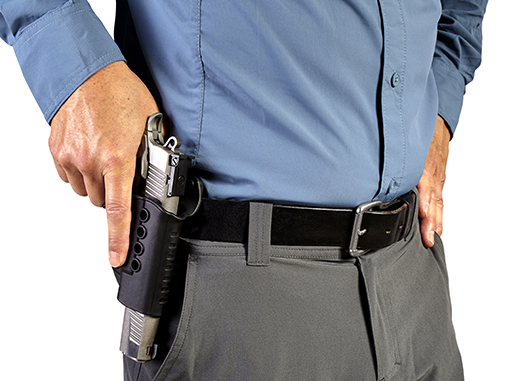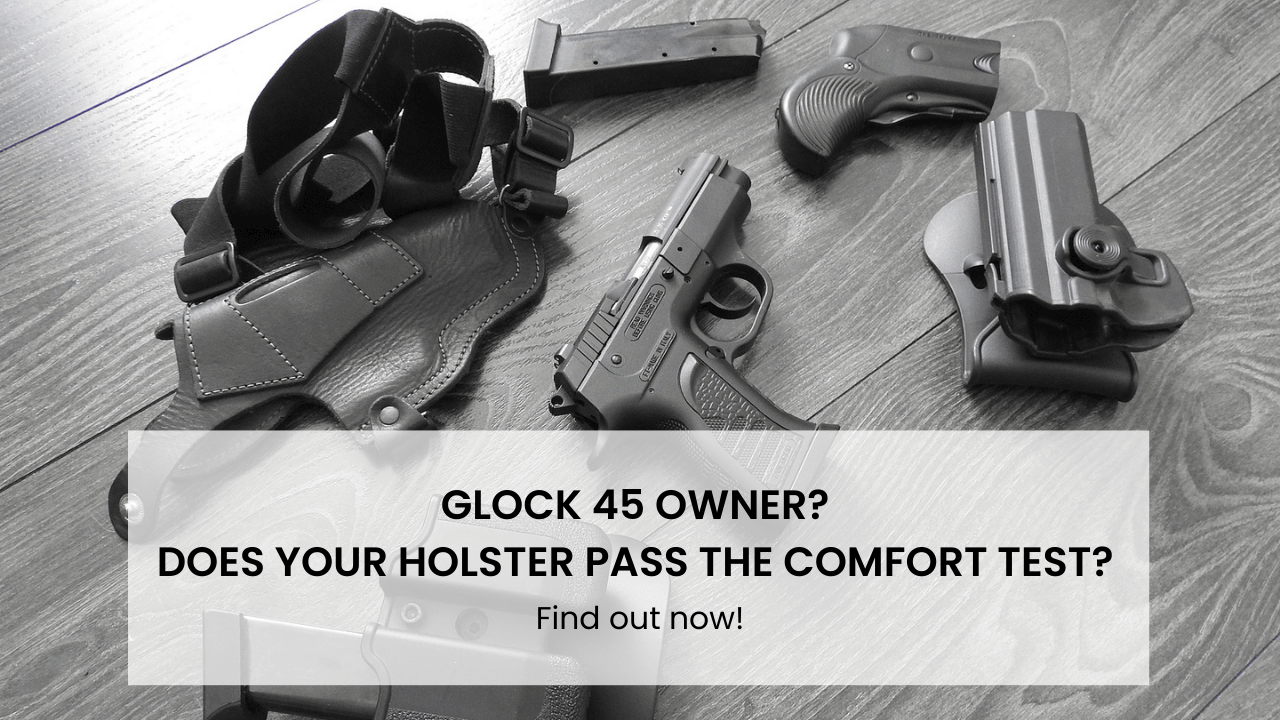Which is Better: Appendix or Strongside?
Apr 14th 2021

American shooters carry firearms in a variety of ways, depending on a multitude of factors. The most common concealed carry positions are on the waistband, led by appendix carry and strongside carry. But what do these terms mean, and how do they translate to real-life scenarios?
Waistband Carry
If you carry a holster attached to your belt, whether IWB or OWB, you’re carrying using a waistband holster. Gun owners typically use hour-hand positions on a 12-hour clock face to indicate the holster’s position on the belt. For example, your navel or belt buckle is at the 12 o’clock position, and the small of your back is at 6 o’clock.
There are several waistband holster positions that you can experiment with, but the two most common are appendix and strongside.
Strongside
Your strong hand is your dominant hand. When you draw your weapon from its holster, you perform this action with your strong hand.
Your strong side is the side that corresponds to your strong hand. If you’re a right-handed shooter, your strong side is on or behind your right hip — 3 o’clock to 5 o’clock. If you’re a southpaw, your strong side is on your left hip — 9 o’clock through 7.
Strongside carry is the default waistband holster position for concealed carriers and law enforcement.
Advantages of Strongside Carry
Fast draw
The strongside position offers considerable speed compared with other waistband holster positions. Your hand falls naturally beside your gun, and you’re able to fire from retention simply by pointing the muzzle upward once it’s clear of the holster. It’s also one of the most efficient positions to draw from.
Range safe
Compared with cross-draw and shoulder holsters, the strongside holster reduces the probability that you inadvertently cover yourself or a bystander during your draw stroke. This is one reason that strongside hip carry is the preferred position on firing ranges and tactical courses — you’re less likely to sweep the firing line.
Support hand defense
As you draw your weapon with your strong hand, you’re able to raise your weak or support hand — your non-dominant hand — to keep the bad guy away from your gun. It also allows you to keep the threat away from your weapon, blading the weaker side of your body toward the threat.
Disadvantages of Strongside Carry
Disclosure
If you place your firing hand on the grip of your pistol in anticipation of a threat, this can reveal your weapon and, depending on the jurisdiction, may be considered brandishing. If you blade your body toward the target, you can place your hand on the gun without the imminent threat knowing. However, this body language may still convey your intentions.
Vehicle carry
Carrying your handgun strongside while seated in a vehicle poses challenges for your draw stroke. You’ll have to negotiate the seatbelt, which can be difficult under stress. If you also have to sweep a cover garment aside to access your firearm, this can quickly become impractical. As a result, if you spend prolonged periods behind the wheel of a car or truck, you may consider investing in a dedicated vehicle holster or quick-access gun safe.
Appendix Carry

The appendix position corresponds to the 12 o’clock or 1 o’clock position. If you’re carrying AIWB — appendix carry inside the waistband — the holster is either directly behind your belt buckle or beside it.
This method of carrying a gun has gained traction among some competition and tactical shooters. However, appendix carry is probably the single most controversial concealed-carry position due to an ongoing debate regarding its safety.
Advantages of Appendix Carry
Before detailing the controversy regarding appendix carry, it’s worth examining the advantages of this carry position.
Fast draw
Strongside is fast, but many proponents of appendix carry insist that it is faster because the gun is always in front of you, and your hand has less distance to travel when accessing and drawing your weapon. If you wear a jacket or coat, there’s no need to sweep away fabric to access your firearm. An untucked shirt is a common cover garment, but tucked-in shirts are also popular.
Easy to draw
Some shooters with shoulder injuries may find the strongside carry position challenging to draw from due to the need to raise the shoulder. In appendix carry, the draw stroke only requires that you lift your hand and forearm.
Concealable
Printing, which is when the gun forms a visible outline through clothing, thereby disclosing that you’re armed, is something to avoid when carrying a concealed firearm. While your wardrobe and choice of holster impact this, the positioning also matters. In appendix holsters, the gun fits snugly against your abdomen, allowing clothing to drape over it. This is less likely to produce a telltale bulge through a jacket.
Disadvantages of Appendix Carry
Safety
The safety concern regarding the appendix carry position is simple. When the gun is holstered, the muzzle is pointing toward your groin and femoral artery. If you experience an accidental discharge in this position, the bullet is more likely to inflict a fatal injury than the strongside position.
The first way to mitigate the risks associated with appendix carry is to consistently follow firearm safety rules. The second safety precaution you can take is to select an appropriate holster. OWB and IWB holsters that deform or collapse will render the reholstering process more dangerous. Your holster should be rigid and remain open when empty.
You can also reholster your weapon carefully. If you’re reholstering your weapon, the threat has presumably dissipated — take your time and watch what you’re doing.
Sitting
Many gun owners find that sitting while wearing an appendix holster is uncomfortable because the holster digs into the groin or leg. This may be less of a concern when carrying a compact or subcompact semi-auto pistol, but you should still be wary.
Beltline
If you’re a bulkier individual with a more pronounced beltline, appendix carry is probably not for you. This complicates access and reduces comfort.
Choose What’s Right For You
At Incognito Concealment, we have experience with both the appendix and strongside carry positions. If you’d like to explore your options regarding these carry methods to choose the best holster for your needs, give us a call at (586) 999-5820.











